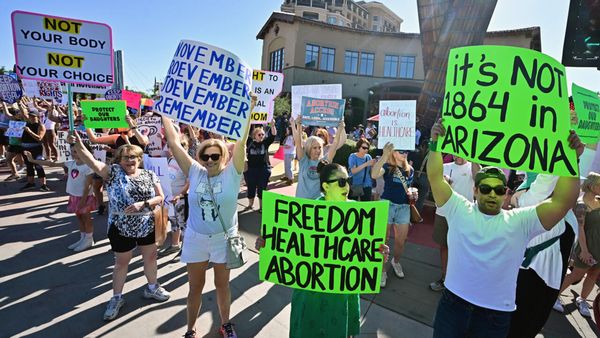
Just a few years ago, a clear majority of Americans trusted the Supreme Court. Now, a month after Roe v. Wade was overturned, poll after poll shows that a clear majority of Americans do not.
To which many of the Court’s closest observers would say, “What took so long?”
For more than a decade, the Court has issued narrow rulings, decided by slim majorities, that align with Republican political goals. Five Justices unleashed dark money in politics. They gutted the Voting Rights Act. They pulled the rug out from under public-sector unions. In that sense, Dobbs—the decision overturning Roe—is part of a larger trend.
But the American public is right to see Dobbs as different. Not just because of the decision’s impact, or the outrage it’s caused. More than a radical opinion, Dobbs represents a radical new approach to interpreting the Constitution. If left unchecked, the justices’ decision could mark not just the end of Roe, but the upending of America’s system of checks and balances.
Understanding why Dobbs is so dangerous, both to American society and to the American republic, starts with a principle known as stare decisis, which has guided the Court since at least the mid-19th century. Latin for “To stand by things decided,” its plain-English meaning is fairly simple. The Court should follow its past precedents. Current justices shouldn’t undo what past justices have already done, even if they think those past justices were wrong.
Stare decisis does not bind judges’ hands entirely. It does, however, restrain them. When the Court’s majority feels a past case was wrongly decided, it is expected to rule narrowly instead of broadly, chipping away at old precedents and only gradually establishing new ones. It’s the legal equivalent of choosing renovation over demolition. The law should evolve rather than lurch.
[Nikolas Bowie and Daphna Renan: The Supreme Court is not supposed to have this much power]
No less important, by following stare decisis, justices recognize that the Court is bigger than the people who happen to be serving on it, with decisions that outlast the people who make them. The judiciary is supposed to be informed by historical memory, and guided by more than its members’ whims. Stare decisis is what makes the Court an institution. Without it, the judiciary is just a collection of opinionated people.
Perhaps this is why, although Clarence Thomas has publicly rejected stare decisis, his fellow conservatives still claim to take it seriously. In their confirmation hearings, Justices Samuel Alito, Neil Gorsuch, Brett Kavanaugh, and Amy Coney Barrett each promised to respect settled law. And as they each pointed out, the right to abortion was not only settled in 1973, but upheld in a separate 1992 decision, Planned Parenthood v. Casey. They agreed that Roe v. Wade was not just precedent, but precedent upon precedent, wrapped in a double layer of stare decisis protection.
They overturned it anyway.
Writing for the majority in Dobbs, Alito went out of his way to reassure the American people that, regardless of what he and his colleagues had said in their public hearings, there was nothing radical about what the Court was doing. Over and over, Alito and his fellow conservatives pointed to Brown v. Board of Education, the Court’s 1954 decision overturning Plessy v. Ferguson and ending the “separate but equal” doctrine behind Jim Crow, to suggest that the Court has always jettisoned precedents it finds particularly distasteful.
“Like the infamous decision in Plessy v. Ferguson,” read the Court’s official summary of Dobbs, “Roe was also egregiously wrong and on a collision course with the Constitution from the day it was decided.”
[From the July 1954 issue: Segregation and the Supreme Court]
But even if you’re comfortable equating overturning abortion rights with ending public-school segregation, Alito’s comparison doesn’t work. If anything, it underscores just how radical the Dobbs opinion really is.
There are several obvious differences between the opinion overturning Plessy and the opinion overturning Roe. One decision expanded individual liberties while the other curtailed them; one decision reflected evolving public opinion while the other rejected it. But there are also differences that go beyond the issues at hand or public sentiment, and touch on the way the justices in each case approached their historic role as interpreters of the Constitution.
The first of these was pointed out by Chief Justice John Roberts, who joined the 6–3 Dobbs majority that upheld Mississppi’s ban on abortion after 15 weeks but did not support overturning Roe. Citing the “fundamental principle of judicial restraint,” he wrote, “It is only where there is no valid narrower ground of decision that we should go on to address a broader issue, such as whether a constitutional decision should be overturned.”
Roberts’s understanding of stare decisis is hardly welcome news for liberals—he’s found ways to justify all kinds of sweeping conservative decisions—but it does point to a major difference between Brown and Dobbs. Writing for the majority in Brown, Chief Justice Earl Warren pointed out that the Court had recently heard six cases involving segregation in education, but had expressly avoided revisiting Plessy. “In none of these cases,” he wrote, “was it necessary to reexamine the doctrine to grant relief.”
In contrast, Warren argued, questions involving segregated K–12 public schools raised in Brown were so sweeping and wide-ranging that the only way to address them was to address the doctrine that allowed them. One of the opinion’s most famous lines, “Separate educational facilities are inherently unequal,” is not just a repudiation of Jim Crow. It’s a legal rationale for overturning past precedent.
In other words, while the 1954 Court felt Plessy was egregiously wrong, its egregious wrongess was not in itself enough for the Justices to overturn the ruling. They overturned Plessy, they argued, only because they had no other viable choice.
Perhaps the conservatives in Dobbs felt similarly about Roe, but that’s not the standard they used to justify their decision. Instead, in a concurring opinion, Kavanaugh laid out his own set of rules for disregarding precedent: “(i) the prior decision is not just wrong, but is egregiously wrong, (ii) the prior decision has caused significant negative jurisprudential or real-world consequences, and (iii) overruling the prior decision would not unduly upset legitimate reliance interests.”
The problem with Kavanaugh’s checklist is that each of its elements is completely subjective. In essence, Kavanaugh believes judges should unfailingly abide by past decisions unless they really don’t want to. That’s not a way to apply stare decisis. It’s a way to scrap it. In his concurrence, Roberts seems to recognize that he disagrees with his fellow conservatives about the value of sticking to the Court’s historic principles. “The Court’s decision to overrule Roe and Casey is a serious jolt to the legal system—regardless of how you view those cases,” he wrote.
Which leads to the other major difference between Brown and Dobbs. Brown was decided by a 9–0 vote. This unanimity sent a message that the Court’s decision was not only overdue but obvious: Justices from across the ideological spectrum were able to agree that Plessy was wrongly decided. In his opinion, Warren further argued that the Court’s change of heart was not just motivated by changing public sentiment or the 1954 justices holding a different set of views from those in 1896. In a way that may not have been understood or appreciated when Plessy was issued, Warren wrote, segregated schools created a psychological “sense of inferiority” that made them fundamentally unequal. In much the way a jury, when presented with exculpatory evidence, might change its verdict from guilty to innocent, the Court changed its opinion as new facts came to light.
[Read: Why the Supreme Court needs term limits]
The majority in Dobbs made no such argument. Five judges—Alito, Barrett, Gorsuch, Kavanaugh, and Thomas—supported overturning Roe. The remaining four did not. The only reason these numbers were not 5–4 in the other direction is that Ruth Bader Ginsburg died while President Donald Trump was still in office and a conservative nominee was rushed through the Senate. If she had been replaced by President Joe Biden instead (or if, four years earlier, Republicans hadn’t broken with Senate tradition and refused to allow President Barack Obama to fill an open seat on the Court), conservatives would not have been able to overturn Roe. Women were deprived of a right they had held for nearly 50 years not because jurisprudence evolved or judges gained a new understanding of the real-world impact of a past decision, but because one judge was swapped for another.
As the Court’s three liberals wrote in their joint dissent, “The Court reverses course today for one reason and one reason only: because the composition of this court has changed.”
Most Americans may not know what stare decisis means, or exactly why the Dobbs ruling was antithetical to it, but judging from public polling, they understand that a line has been crossed. The judiciary is now bound only by the whims of the judges who happen to serve in it, distinguished less by its unique role in American government than by the fact that, unlike its political colleagues in the House of Representatives, the Senate, and the White House, its lawmakers are unelected and serve lifetime terms.
Most Americans would agree that this is bad for the country. In the aftermath of Dobbs, businesses and governments are trying to figure out which rights the Court will un-guarantee next. Same-sex marriage? Same-sex intimacy? Birth control? Free and fair elections? Will they erase long-standing laws allowing the American people, through republican governance, to fight climate change, promote public safety, or preserve the separation of Church and state? We have only begun to reckon with what it means to live in a country whose most powerful judicial body no longer believes in judicial restraint.
But stare decisis is not only in the public’s interest. It is—or perhaps was—in the Supreme Court’s interest as well.
It’s hard to imagine today, but the judiciary was initially, by far, the least powerful of the three branches of government created by the Constitution. The history of the American courts, and of the Supreme Court in particular, is one of steadily growing influence—the ability to interpret the Constitution, the ability to overturn both federal and state laws, the jurisdiction over nearly any case a court takes an interest in—with remarkably little backlash from either the public or the other two branches of government.
There are several reasons the judiciary has been so rarely checked and balanced. But perhaps the most important one is that, from its earliest days as the self-proclaimed arbiter of the Constitution, the Supreme Court has used stare decisis to check and balance itself. In essence, the justices made the other two branches of government an offer: If you give us more power, we will limit how we use it.
For hundreds of years, that bargain held. Now, as even Chief Justice Roberts recognized, the Court’s right-wing majority has reneged on its end of the deal. With centuries of accumulated power at its disposal, the judiciary plans to use that power less cautiously than ever before.
We are not just living in a moment without precedent. We are living in a moment without precedents. Such unprecedented times call for unprecedented reforms.







